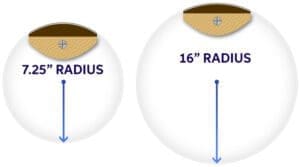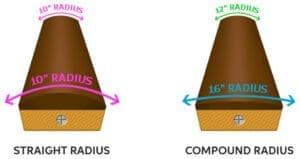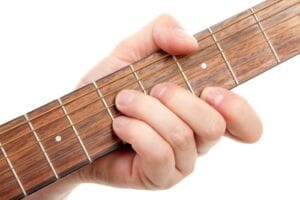Guitar necks are a crucial instrument component that significantly affects playability and comfort. It is essential to understand the different aspects of guitar necks, such as shape and radius, to choose the right one for your needs.
In this article, we will explore the most common neck shapes, how to identify them, the significance of neck radius, and answer some frequently asked questions about guitar necks.
Table of contents
Most Common Guitar Neck Shapes
Guitar necks come in various shapes, offering a unique feel and playing experience. The four primary neck shapes are:


‘U’ Shape Neck
This neck shape has a pronounced curve, resembling the letter “U.” It provides a substantial grip and is often favored by players who prefer a chunky and robust feel.
‘V’ Shape Neck
The ‘V’ shape neck features a sharp V-shaped profile, offering a vintage feel. It is commonly associated with classical guitars and provides a comfortable grip for players who like to rest their thumbs on the back of the neck.
‘C’ Shape Neck
The ‘C’ shape neck is among the most popular neck profiles. It has a gentle curve that provides a balanced and versatile feel, suitable for various playing styles and hand sizes.
‘D’ Shape Neck
Similar to the ‘C’ shape, the ‘D’ shape neck offers a comfortable and rounded profile. It is slightly thicker than the ‘C’ shape and is favored by players who prefer a fuller grip.
How to Find What Neck Shape Your Guitar Is
To determine the neck shape of your guitar, you can examine the back of the neck. Run your hand along the neck to feel its profile.
Additionally, you can consult the manufacturer’s specifications or refer to the guitar’s model documentation for more information.
Understanding Guitar Neck Radius
The guitar neck radius refers to the curvature of the fretboard. It dramatically affects how the strings respond and how comfortably your fingers can navigate the frets.


The two main types of neck radius are:
Small Radius
A small radius means a more pronounced curve on the fretboard. This is typically found in vintage-style guitars and offers a tighter feel, suitable for players who enjoy bending strings and playing chords with a lot of grip.


Large Radius
A large radius indicates a flatter fretboard curvature. It provides more space between the strings and allows for easier string bending and faster soloing. This is often preferred by players who engage in intricate lead playing.
How Fretboard Radius Impacts Playability
The fretboard radius affects the guitar’s action or string height. A smaller radius may result in higher action, requiring more effort to press down the strings.
On the other hand, a larger radius tends to offer lower action, allowing for smoother and faster playing with less finger fatigue.
How To Choose a Guitar Neck Shape
Choosing a guitar neck shape ultimately comes down to personal preference and comfort. Here are some factors to consider:
Hand Size
A slimmer neck profile, such as a ‘C’ or ‘D’ shape, may be more comfortable if you have smaller hands. Larger hands may find chunkier neck shapes more suitable, like the ‘U’ or ‘V’ shapes.
Playing Style


Different neck shapes cater to specific playing styles. For example, players focusing on chord progressions may prefer a neck shape that provides a solid grip, while lead guitarists might opt for a slimmer neck for faster soloing.
Experimentation
Different neck shapes are the best way to determine what feels comfortable. Visit guitar stores and test various guitars with different neck profiles to find the one that suits your playing style and preferences.
Best Neck Shape for Small Hands
For players with smaller hands, a neck shape with a slimmer profile, such as a ‘C’ or ‘D’ shape, is generally more comfortable.
These shapes allow for easier reach and less strain when navigating the fretboard. However, it is crucial to try different neck shapes and find the one that feels most comfortable for your specific hand size.
Asymmetrical Necks
An asymmetrical neck offers a unique blend of comfort and playability. It is designed to accommodate the natural shape of the hand, providing a more ergonomic grip.
Asymmetrical necks often have a thinner profile on the bass side and a slightly thicker profile on the treble side, which caters to the different demands of chord playing and lead playing.
Guitar Neck Profiles


Symmetrical necks, such as the ‘C’ or ‘U’ shape, offer a consistent feel throughout the neck. They are generally favored by players who prefer a uniform grip and consistent playing experience.
On the other hand, asymmetrical necks, like the Strandberg Endurneck, offer a tailored grip for each hand’s natural shape. They provide increased comfort and can alleviate hand fatigue during extended playing sessions.
Scale Length


A guitar’s scale length is the distance between the bridge and the nut.
Neck Shapes FAQ
Common questions and answers about guitar necks
What is the Best Guitar Neck Shape?
The best guitar neck shape is subjective and depends on your preference, playing style, and hand size. Try different neck shapes to see which feels the most comfortable and allows for easy playability.
Are There Different Size Necks?
Yes, guitar necks come in various sizes. Some guitars have slimmer neck profiles, while others have chunkier necks. Finding a neck size that suits your hand size and playing style is essential for optimal comfort.
Are Wide Neck Guitars Easier to Play?
Wide-neck guitars can offer more space between the strings, making it easier for players with larger hands to navigate the fretboard. However, it is only sometimes more accessible for everyone. The best neck width depends on personal preference and comfort.
What Does a Fast Neck Mean?
A fast neck profile allows for quick and effortless playing, particularly for lead guitarists. It usually has a slimmer profile and a flatter fretboard radius, allowing for easier string bending and faster movements along the neck.
Summary
Choosing the right guitar neck shape is crucial for comfortable and enjoyable playing. The most common neck shapes include ‘U,’ ‘V,’ ‘C,’ and ‘D’ shapes, each offering a unique feel—the neck’s radius, whether small or large, impacts playability and string bending.
Experimenting with different neck shapes and sizes is essential to find what suits your hand size and playing style. Asymmetrical necks, like the Strandberg Endurneck, provide increased comfort by accommodating the natural shape of the hand. Ultimately, selecting the best guitar neck shape is subjective, and finding what feels most comfortable and facilitates your playing style is essential.



